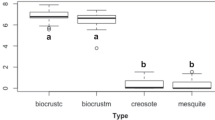Summary
Nineteen bryophyte species containing epiphytic cyanobacteria on Marion Island (46°54′ S, 37°45′ E) were investigated for their capacity to reduce acetylene in the field. Fourteen species exhibited reduction, varying from 0.36 to 310.57 nmol C2H2 g-1 dry weight h-1. These values are within the range of those reported from northern hemisphere subpolar sites. The highest reduction rate occurred at a highly minerotrophic mire receiving nutrient-rich run-off from an adjacent bird-occupied slope. The lowest non-zero values occurred in moss-balls growing on exposed, wind-swept rocky ridges. Multiple regression analysis indicated a strong correlation between acetylene reduction rate and sample water content, with cyanobacteria abundance the next most important variable. Under the incubation conditions employed neither temperature nor radiation were related to reduction rate. In view of the predominance of bryophyte-dominated communities in the island vegetation it is likely that fixation of N by bryophyte-cyanobacteria associations forms an important contribution of reduced N to the ecosystem.
Similar content being viewed by others
References
Alexander V (1974) A synthesis of the IBP tundra biome study of nitrogen fixation. In: Holding AJ, Heal OW, MacLean SF, Flanagan PW (eds) Soil organisms and decomposition in tundra. Tundra Biome Steering Committee (Publ), Stockholm, pp 109–121
Alexander V (1975) Nitrogen fixation by blue-green algae in polar and subpolar regions. In: Stewart WDP (ed) Nitrogen fixation by freeliving micro-organisms. Cambridge University Press (IBP 6), pp 175–188
Alexander V, Billington M, Schell DM (1978) Nitrogen fixation in Arctic and alpine tundra. In: Tieszen LL (ed) Vegetation and production ecology of an Alaskan Arctic tundra. Springer, Berlin Heidelberg New York (Ecological Studies, vol 29, pp 539–558)
Alexander V, Schell DM (1972) Seasonal and spatial variation of nitrogen fixation in the Barrow, Alaska, tundra. Proc 1972 Tundra Biome Symposium, pp 94–98
Basilier K, Granhall U (1978) Nitrogen fixation in wet minerotrophic moss communities of a subarctic mire. Oikos 31:236–246
Croome RL (1973) Nitrogen fixation in the algal mats on Marion Island. S Afr J Antarct Res 3:64–67
Fogg EG, Stewart WDP (1968) In situ determinations of biological nitrogen fixation in Antarctica. Br Antarct Surv Bull 15:39–46
Granhall U (1981) Biological nitrogen fixation in relation to environmental factors and functioning of natural ecosystems. In: Clarke FE, Rosswall T (eds) Terrestrial nitrogen cycles. Swedish Natural Sciences Research Council, Stockholm (Ecological Bulletins 33, pp 131–144)
Granhall U, Basilier K (1973) Nitrogen fixation in tundra moss communities. IBP Swedish Tundra Biome Tech Rep no 14, pp 174–190
Granhall U, Lid-Torsvik V (1975) Nitrogen fixation by bacteria and free-living blue-green algae in tundra areas. In: Wielgolaski FE (ed) Fennoscandian tundra ecosystems, part 1. Plants and microorganisms, Springer, Berlin Heidelberg New York (Ecological Studies, vol 16, pp 305–315)
Gremmen NJM (1981) The vegetation of the Subantarctic islands Marion and Prince Edward. Geobotany 3. Dr W Junk, The Hague
Heywood RB (1968) Ecology of the freshwater lakes of Signy Island, South Orkney Islands. II. Physical and chemical properties of the Lakes. Br Antarct Surv Bull 18:11–44
Horne AJ (1972) The ecology of nitrogen fixation on Signy Island, South Orkney Islands. Br Antarct Surv Bull 27:1–18
Kallio P, Suhonen S, Kallio H (1972) The ecology of nitrogen fixation in Nephroma arcticum and Solorina crocea. Rep Kevo Subarctic Res Stat 9:7–14
Lindeboom HJ (1979) Chemical and microbiological aspects of the nitrogen cycle on Marion Island (Sub-Antarctic). PhD thesis, Ryksuniversiteit te Groningen, The Netherlands
Schell DM, Alexander V (1973) Nitrogen fixation in Arctic coastal tundra in relation to vegetation and micro-relief. Arctic 26:130–137
Smith VR (1976) The effect of burrowing species of Procellariidae on the nutrient status of inland tussock grasslands on Marion Island. J S Afr Bot 42:265–272
Smith VR (1979) The influence of seabird manuring on the phosphorus status of Marion Island (Subantarctic) soils. Oecologia 41:123–126
Smith VR, Ashton PJ (1981) Bryophyte-cyanobacteria associations on Subantarctic Marion Island: are they important in nitrogen fixation? S Afr J Antarct Res 10/11 (in press)
Stewart WDP, Alexander V (1971) Phosphorus availability and nitrogenase activity in aquatic blue-green algae. Freshwater Biol 1:389–406
Author information
Authors and Affiliations
Rights and permissions
About this article
Cite this article
Smith, V.R., Russell, S. Acetylene reduction by bryophyte-cyanobacteria associations on a Subantarctic island. Polar Biol 1, 153–157 (1982). https://doi.org/10.1007/BF00287001
Received:
Accepted:
Issue Date:
DOI: https://doi.org/10.1007/BF00287001




